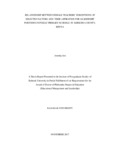RELATIONSHIP BETWEEN FEMALE TEACHERS’ PERCEPTIONS OF SELECTED FACTORS AND THEIR ASPIRATION FOR LEADERSHIP POSITIONS IN PUBLIC PRIMARY SCHOOLS IN KERICHO COUNTY, KENYA
Abstract
Although more women today are joining the teaching profession, a gender gap in leadership in favour of men persists in primary schools in Kenya. Notably, women hold less than 20% of all leadership positions in primary schools in Kericho County. This study investigated the relationship between the perceptions of selected factors and aspirations of female teachers for primary school leadership positions in Kericho County. This research is founded on the Theory of planned behaviour and the Model of Administrative Career Mobility, from which a conceptual framework was formulated. A mixed method design was utilized. A survey questionnaire and an interview schedule were used to collect data. The study population consisted of all 461 public primary schools in Kericho County. The study employed stratified and simple random sampling techniques to sample 327 female teacher respondents from the target population. Female senior teachers and deputy head teachers were purposively sampled from the sample of schools. This study employed the concurrent triangulation strategy to analyse and interpret data. Descriptive techniques, One-Way Analysis of Variance, the Pearson Product Moment correlation and regression analysis were used to analyse the quantitative data. The qualitative data obtained from the interviews were transcribed, organized into categories, sub categories and themes, and presented in prose form. The study established that the perceptions of sociocultural factors were not significantly correlated with leadership aspiration with a coefficient of -0.095 at p-value of 0.05. There was a weak negative significant relationship between the perception of institutional factors and leadership aspiration with a coefficient of -0.123 at a p-value of 0.05, accounting for 1.5% of the variability in leadership aspiration. There was a significant positive relationship between selfefficacy of the female teacher and their leadership aspiration with a coefficient of 0.373 at p-value of 0.05, accounting for 14% of the variability in leadership aspiration. Overall, about 16% of the variability in female teachers’ leadership aspirations was explained by the studied variables. The qualitative findings confirmed the influences of the factors explored in the study. The study concluded that self efficacy and perceptions of institutional factors influence the female teachers’ leadership aspiration. The study recommended that school policies based on equal opportunity principles should be developed to create a leadership team in primary schools. It also recommends the development of programs for enhancing the access of female teachers to leadership positions in primary schools in light of their high aspiration for leadership. The study also contributes to the body of literature on women in educational leadership in Kenya.

